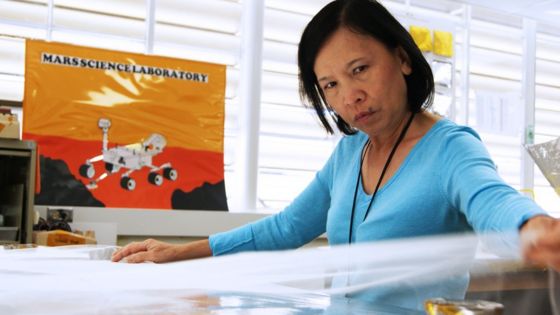
Without its seamstresses, many of Nasa`s key missions would never have left the ground.
From the Apollo spacesuits to the Mars rovers, women behind the scenes have stitched vital spaceflight components.
One of them is Lien Pham, a literal tailor to the stars - working in the Jet Propulsion Laboratory`s shield shop to create thermal blankets, essential for any spacecraft leaving Earth.
It may not sound glamorous, but Lien does work with couture materials.
The Cassini mission, her first project at Nasa, went to Saturn cloaked in a fine gold plate for durability over its 19-year journey.
Your shoes have more in common with interplanetary spacecraft than you might think - thermal blankets are created on the same industrial sewing machines as footwear, and then laced onto the spacecraft so they don`t come loose during launch.
Growing up in Vietnam, Lien "never dreamed" of working for Nasa, least of all sewing for the space agency.
But when her family fled the country in the late 1970s after the fall of Saigon, she found herself in the US, needing to make enough money to support six siblings.
The family bought two sewing machines and began to sell clothes from their home, sewing by night.
"We did dresses, blouses, shirts, and other things. We got paid maybe 50 cents per garment," she tells 100 Women.
What is 100 Women?
BBC 100 Women names 100 influential and inspirational women around the world every year. This week marks 150 years since the birth of Marie Curie and we are celebrating women in science all week. Join us on Facebook, Instagram and Twitter, and let us know about your favourite scientists on #100Women
Working a day job at a lingerie company, once a week Lien went to electrical engineering classes.
At that time, engineering was a booming business in California. And Nasa were hiring.
Lien`s friend recommended that she apply for a job at the Jet Propulsion Laboratory and in 1994 she started work at the space agency - on the cabling team for the Cassini mission to Saturn.
The intricate job of connecting all the separate scientific instruments on the spacecraft to a central power supply was very demanding - it took her team three years.
"Just like a sewing factory is mostly women… cabling is mostly women because we`re good with our hands," she says.
The thermal blanketing team, or the shield shop as it`s known, is a small group made up mostly of women. They carefully stitch together over 20 individual layers - some just 1/1000th of an inch thick.
Each blanket is patterned, measured and fitted, like the finest suit.
"It`s all tailored," Lien explains, "all hand made."
Nasa hires women with sewing experience for a reason. When engineers couldn`t figure out how to work with Teflon - the non-stick material that coats many saucepans - they were at a loss.
Lien suggested folding the edge of the material and sewing it like a hem, as she would with a shirt at home.
Lien is the latest in a long line of women whose crafting skills have been vital to Nasa. During the Apollo programme, which sent the first humans to the moon, employees at defence contractor Raytheon were employed to "weave" the software for the spacecraft.
Referred to as the "little old ladies", many of them were in fact young women, threading copper wires through tiny magnetic loops to create the individual ones and zeros of programme code. Their role in this time consuming and incredibly precise process was largely invisible to the outside world.
Similarly, the seamstresses of lingerie brand Playtex pioneered new sewing techniques to create the Apollo spacesuits. Working to unprecedented levels of precision, and often late into the night, their innovations made human spaceflight possible.
Much like the hidden figures of Nasa`s aeronautics research facility, many of their stories go untold.
However, for Lien, the work itself is a dream come true.
"I would look up at the sky when I was little, and I thought it would be nice to touch one of those stars. But then I came here and got to build something that would go there."
"Never in my imagination could I have believed that.


0 comments:
Post a Comment